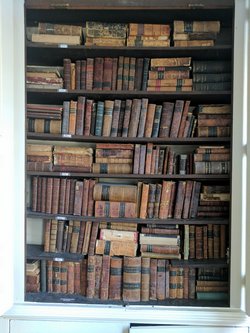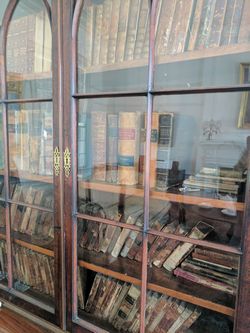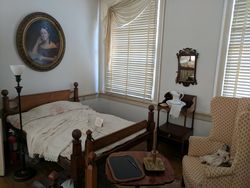This article is part of the series "A Moment in History" where we honor those who have contributed to the growth of medical knowledge in the areas of anatomy, medicine, surgery, and medical research.
This is the continuation of the article “The Ephraim McDowell House and Museum (1)”
The first room we visited from the foyer was the library. Antique furniture, elegant oil lamps and in wooden built-in-the-wall shelfs an incredible collection of antique books from the 1700-1900’s covering everything from medicine and surgery to history, philosophy and poetry. One of the shelves pictured here had mostly medical books.
As a book collector I was so tempted to touch, open, and read some of the books, but they are only for display. I could recognize some of the books as items that I would like to own and place in my library. The docent explained that, as the custom of the times, the library was the place for men to meet, smoke, read, share a bourbon, and discuss the events and politics of the day.
The next room was the music room. Dr. McDowell played the violin while his wife played the piano, both on display as well as other antique instruments donated to the museum. Antique furniture and over the fireplace mantle two whale oil lamps. There are family portraits all over the house. One can almost imagine the life of the times…
One of the library book shelves
More books in the music room
The music room
Interestingly, there is a large wooden door that opens from the foyer to the patio. The guide explained that it was a “casket door” so that people who died in the house could be taken through the door to the back of the house and not through the front door.
A wooden staircase leads to the second floor, where there is a small bedroom that was for the children. Because of the number of children, they had to sleep two or three to a bed. There is furniture, antique bedspreads, bedpans (there were no bathrooms in the house), even some toys, dolls, and chalk tablets.
The master bedroom is also on the second floor. Larger and more spacious, it was the place where women would get together to talk, knit and quilt. On the mantelpiece there is a family sword.
The next room is the “operating room” where history was made on Christmas Day, 1809.
This article continues here.







